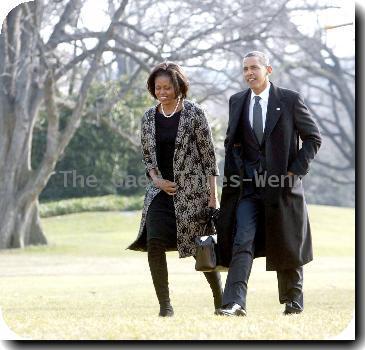China reports $7.24 billion trade deficit in March as imports surge, first in almost 6 years
By Elaine Kurtenbach, APFriday, April 9, 2010
China’s $7.24B March trade deficit 1st in 6 years
SHANGHAI — China reported its first monthly trade deficit in nearly six years in March, a shift expected to be short-lived and one that may give Beijing only a slight respite from pressure to revalue its currency.
The $7.24 billion trade deficit in March reported Saturday by China’s customs administration was China’s first since a $2.26 billion deficit in April 2004. Though expected, it was significantly bigger than many economists had forecast. It follows four straight months of narrowing trade surpluses.
The return to deficit after many years of surplus comes as China is being pressured to let the value of its currency rise against the dollar — a key source of friction with the U.S. and other trading partners.
Zheng Yuesheng, chief of the customs agency’s statistics department, said the 60 percent rise in China’s imports in January-March, compared to a year earlier, was a boon to “the balanced growth of the world economy.”
“This kind of trade deficit is healthy because it appears when exports and imports both grow rapidly,” Zheng said on national television.
Zheng echoed other officials in predicting that China’s trade will soon return to surplus, though he said that it will likely tend to be more balanced than in the past.
China’s exports totaled $112.11 billion in March, up 24.3 percent from a year earlier. Imports reached $119.35 billion, up 66 percent compared to the same period last year, the Customs Administration said in data posted on its Web site.
In the first three months of this year, China still posted a global trade surplus of $14.5 billion, down 76.7 percent from the first quarter of 2009. The trade surplus was $7.6 billion in February and the combined January-February surplus was $21.8 billion.
The overall March deficit still shows that demand in China remains strong, driven in part by a torrent of bank lending and other government stimulus. As a result, prices for crude oil, iron ore and other raw materials China imports have been rising. Meanwhile, the Western economies that are the top export markets for Chinese goods have yet to return to solid growth, though are expected to revive later this year.
“China’s trade deficit will likely prove temporary. With an anticipated recovery in developed economies this year, Chinese exports should improve gradually over the coming months,” Jing Ulrich, head of China equities for J.P. Morgan, said in a note to clients.
Chinese trade officials, however, pointed to the deficit and the absence of full-throttle recovery in the global economy as reasons to keep the yuan stable. Appreciating the currency, they argue, would hurt China’s already hard-pressed exporters and add more uncertainty to the world economic outlook.
“We are still very much concerned. Global demand is still weak and protectionism is rising,” Chinese Vice Commerce Minister Yi Xiaozhun said at a regional conference, the Boao Forum for Asia, on Saturday.
In a separate statement, the Commerce Ministry said that the deficit shows that “the decisive factor that affects the trade balance is not the exchange rate, it’s the relationship between market supply and demand and other factors.”
Still, China recorded a $9.87 billion trade surplus with the United States in March and a $30.7 billion surplus for the first quarter, the customs figures showed. Imports from the U.S. rose 43 percent in March, nearly twice the pace of exports.
China’s trade surplus with the European Union was $7 billion in March and $29.3 billion for the first three months of the year.
Persisting trade surpluses have caused U.S. and European leaders to demand Beijing allow the yuan to rise in value, thereby increasing demand within China and perhaps helping to create jobs in the West, which is grappling with high unemployment. American economists estimate that the yuan is undervalued by up to 40 percent, giving its exporters an unfair advantage and swelling its trade surplus.
Some U.S. lawmakers have pushed for President Barack Obama to have China declared a currency manipulator in a Treasury Department report that was due out this month.
In a conciliatory gesture, Washington postponed the report ahead of a visit by President Hu Jintao to the U.S. to attend a nuclear conference. Following a brief stopover in Beijing by Treasury Secretary Timothy Geithner for talks with a top Chinese official, Wang Qishan, many expect Beijing to allow at least a modest change in the yuan’s value.
Beijing has kept the value of the yuan tightly linked to the U.S. dollar for much of the past two decades. After breaking the link in 2005 and allowing the yuan to rise by about 20 percent, it then slammed on the brakes in mid-2008 as the crisis hit and has since held its currency steady against the dollar. The move gave a lifeline to exporters, who shed millions of factory jobs in the plunge in global demand.
Supporters of a loosening of controls on the Chinese currency argue that keeping the yuan’s value steady is helping to fuel inflation and limiting Beijing’s ability to manage the economy effectively.
“China can go a lot further in internationalizing its economy and promoting world growth by making its currency more flexible,” Pieter Bottelier, an economist who formerly headed the World Bank’s Beijing office, told a conference in Shanghai this week.
Associated Press researcher Ji Chen in Shanghai and Henry Hou in Beijing contributed to this report.
Tags: Asia, Barack Obama, Beijing, China, East Asia, Greater China, Hu Jintao, International Trade, North America, Shanghai, United States









